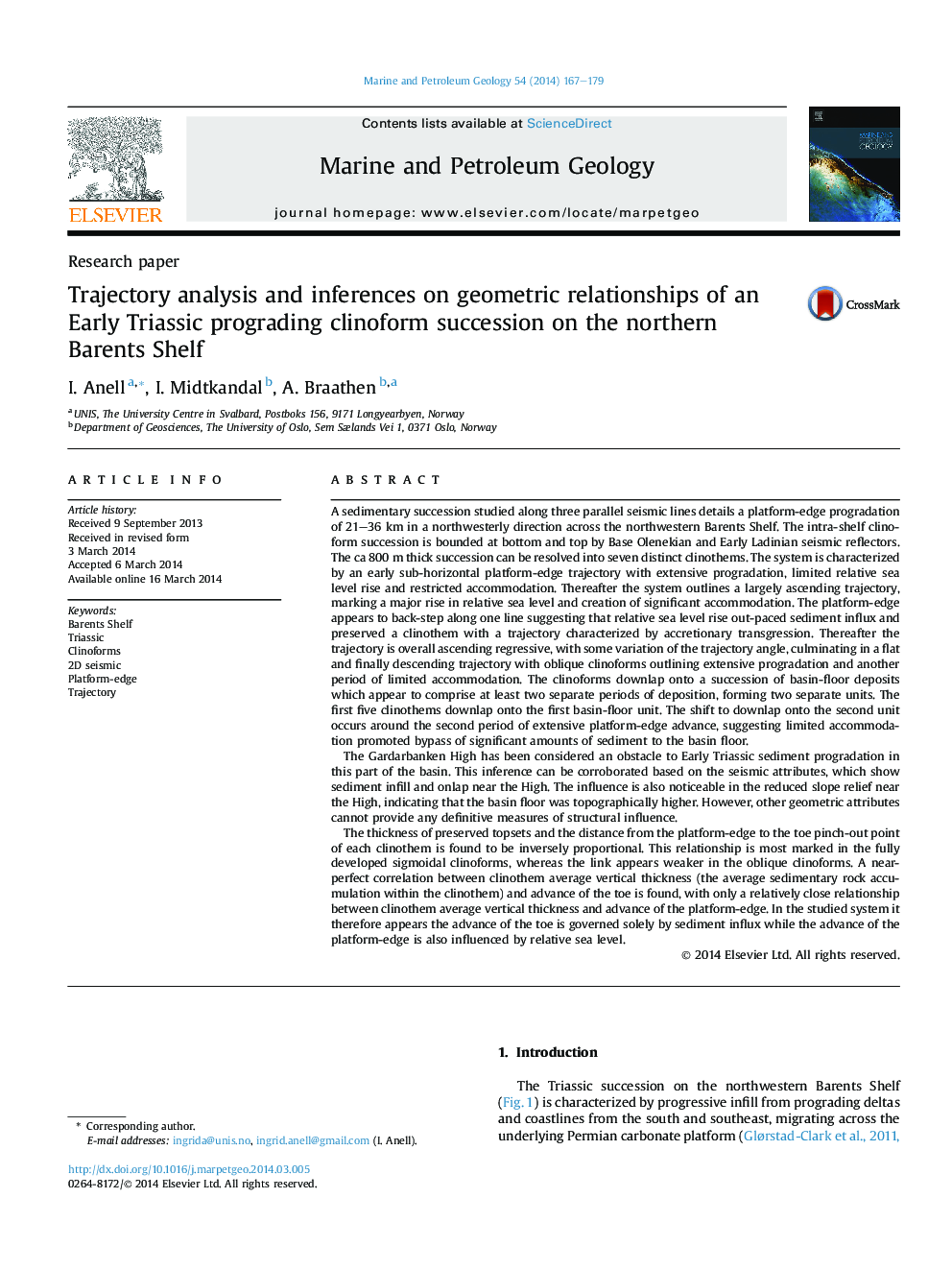| کد مقاله | کد نشریه | سال انتشار | مقاله انگلیسی | نسخه تمام متن |
|---|---|---|---|---|
| 4695580 | 1637170 | 2014 | 13 صفحه PDF | دانلود رایگان |
• We detail a succession of seven Early Triassic clinothems on the northern Barents Shelf.
• The platform-edge trajectory details a full cycle of relative sea-level change.
• We find an inverse relationship between platform-edge to toe distance and thickness of topsets.
• Advance of the toe is governed by sediment influx while shelf-edge advance also by relative sea-level.
• Structural hindrance by the Gardarbanken High is documented.
A sedimentary succession studied along three parallel seismic lines details a platform-edge progradation of 21–36 km in a northwesterly direction across the northwestern Barents Shelf. The intra-shelf clinoform succession is bounded at bottom and top by Base Olenekian and Early Ladinian seismic reflectors. The ca 800 m thick succession can be resolved into seven distinct clinothems. The system is characterized by an early sub-horizontal platform-edge trajectory with extensive progradation, limited relative sea level rise and restricted accommodation. Thereafter the system outlines a largely ascending trajectory, marking a major rise in relative sea level and creation of significant accommodation. The platform-edge appears to back-step along one line suggesting that relative sea level rise out-paced sediment influx and preserved a clinothem with a trajectory characterized by accretionary transgression. Thereafter the trajectory is overall ascending regressive, with some variation of the trajectory angle, culminating in a flat and finally descending trajectory with oblique clinoforms outlining extensive progradation and another period of limited accommodation. The clinoforms downlap onto a succession of basin-floor deposits which appear to comprise at least two separate periods of deposition, forming two separate units. The first five clinothems downlap onto the first basin-floor unit. The shift to downlap onto the second unit occurs around the second period of extensive platform-edge advance, suggesting limited accommodation promoted bypass of significant amounts of sediment to the basin floor.The Gardarbanken High has been considered an obstacle to Early Triassic sediment progradation in this part of the basin. This inference can be corroborated based on the seismic attributes, which show sediment infill and onlap near the High. The influence is also noticeable in the reduced slope relief near the High, indicating that the basin floor was topographically higher. However, other geometric attributes cannot provide any definitive measures of structural influence.The thickness of preserved topsets and the distance from the platform-edge to the toe pinch-out point of each clinothem is found to be inversely proportional. This relationship is most marked in the fully developed sigmoidal clinoforms, whereas the link appears weaker in the oblique clinoforms. A near-perfect correlation between clinothem average vertical thickness (the average sedimentary rock accumulation within the clinothem) and advance of the toe is found, with only a relatively close relationship between clinothem average vertical thickness and advance of the platform-edge. In the studied system it therefore appears the advance of the toe is governed solely by sediment influx while the advance of the platform-edge is also influenced by relative sea level.
Journal: Marine and Petroleum Geology - Volume 54, June 2014, Pages 167–179
